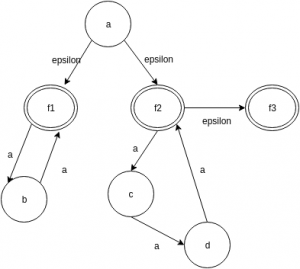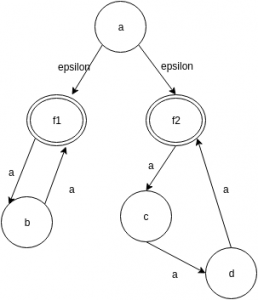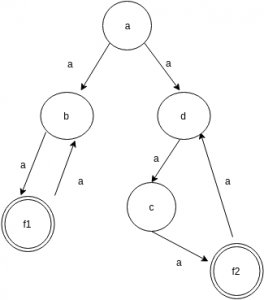This set of Automata Theory Multiple Choice Questions & Answers (MCQs) focuses on “Mealy Machine-II”.
1. Which of the following does not belong to input alphabet if S={a, b}* for any language?
a) a
b) b
c) e
d) none of the mentioned
View Answer
Explanation: The automaton may be allowed to change its state without reading the input symbol using epsilon but this does not mean that epsilon has become an input symbol. On the contrary, one assumes that the symbol epsilon does not belong to any alphabet.
2. The number of final states we need as per the given language?
Language L: {an| n is even or divisible by 3}
a) 1
b) 2
c) 3
d) 4
View Answer
3. An e-NFA is ___________ in representation.
a) Quadruple
b) Quintuple
c) Triple
d) None of the mentioned
View Answer
Explanation: An e-NFA consist of 5 tuples: A=(Q, S, d, q0. F)
Note: e is never a member of S.
4. State true or false:
Statement: Both NFA and e-NFA recognize exactly the same languages.
a) true
b) false
View Answer
Explanation: e-NFA do come up with a convenient feature but nothing new.They do not extend the class of languages that can be represented.
5. Design a NFA for the language:
L: {an| n is even or divisible by 3}
Which of the following methods can be used to simulate the same.
a) e-NFA
b) Power Construction Method
c) Both e-NFA and Power Construction Method
d) None of the mentioned
View Answer
Explanation: It is more convenient to simulate a machine using e-NFA else the method of Power Construction is used from the union-closure of DFA’s.
6. Which of the following belongs to the epsilon closure set of a?

a) {f1, f2, f3}
b) {a, f1, f2, f3}
c) {f1, f2}
d) none of the mentioned
View Answer
Explanation: The epsilon closure of the set q is the set that contains q, together with all the states which can be reached starting at q by following only epsilon transitions.
7. The number of elements present in the e-closure(f2) in the given diagram:

a) 0
b) 1
c) 2
d) 3
View Answer
Explanation: The epsilon closure set of f2 consist of the elements:{f2, f3}. Thus the count of the element in the closure set is 2.
8. Which of the steps are non useful while eliminating the e-transitions for the given diagram?

a) Make a as accepting state of N’ if ECLOSE(p) contains an accepting state of N
b) Add an arc a to f1 labelled a if there is an arc labelled a in N from some state in ECLOSE(a) to f1
c) Delete all arcs labelled as e
d) None of the mentioned
View Answer
Explanation: The given are the steps followed while eliminating epsilon transitions from a NFA or converting an e-NFA to just NFA.
9. Is the language preserved in all the steps while eliminating epsilon transitions from a NFA?
a) yes
b) no
View Answer
Explanation: Yes, the language is preserved during the dteps of construction: L(N)=L(N1)=L(N2)=L(3).
10. Remove all the epsilon transitions in the given diagram and compute the number of a-transitions in the result?

a) 5
b) 7
c) 9
d) 6
View Answer
Sanfoundry Global Education & Learning Series – Automata Theory.
To practice all areas of Automata Theory, here is complete set of 1000+ Multiple Choice Questions and Answers.
If you find a mistake in question / option / answer, kindly take a screenshot and email to [email protected]
- Check Computer Science Books
- Practice Computer Science MCQs
- Check Automata Theory Books
- Apply for Computer Science Internship

